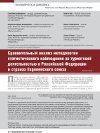Comparison of the Methodology of Statistical Observation in Tourism in the Russian Federation and European Countries
DOI: https://doi.org/10.33917/es-6.180.2021.92-98
The need to harmonize national and international statistical practices in data collection and presentation is based on the desire for comparability of information. In the Russian Federation and the countries of the European Union, a different approach is used to organize and present the results of statistical observation of the tourism industry, including with respect to the classification of accommodation facilities for tourists, tourist trips according to their purposes. In Russia, they do not collect information on identifying the reasons why the citizens of these countries do not take part in tourism, nor do they register quality characteristics. Analysis of international experience shows that tourism statistics receive a lot of attention, with the focus on polling tourists and collective accommodation facilities. In the Russian system of statistical observation in the field of tourism, despite its constant improvement, there is still an acute shortage of data obtained on the basis of regular sample surveys.
Источники:
1. Otchety Vsemirnoi turistskoi organizatsii [Reports of the World Tourism Organization]. Vse o turizme, available at: https://tourlib.net/wto.htm.
2. Statisticheskii ezhegodnik YuNVTO [UNWTO Statistical Yearbook]. UNWTO, available at: https://www.e-unwto.org/
3. Prikaz ot 30 maya 2019 g. N 304 “Ob utverzhdenii ofitsial’noi statisticheskoi metodologii formirovaniya otdel’nykh pokazatelei deyatel’nosti kollektivnykh sredstv razmeshcheniya po polnomu krugu khozyaistvuyushchikh sub”ektov s kvartal’noi periodichnost’yu” [The Official Statistical Methodology for the Formation of Individual Indicators of the Activity of Collective Accommodation Facilities for the Full Range of Economic Entities with a Quarterly Frequency, Approved by Order of Rosstat on May 30, 2019 No. 304]. Kodifikatsiya RF, available at: https://rulaws.ru/acts/Prikaz-Rosstata-ot-30.05.2019-N-304/
4. Reglament (ES) 692/2011 Evropeiskogo parlamenta i Soveta po Evropeiskoi statistike turizma [Regulation (EU) 692/2011 of the European Parliament and of the Council on European Tourism Statistics]. EUR-Lex, available at: https://eur-lex.europa.eu/legal-content/EN/ALL/?uri=celex:32011R0692.
5. Roznichnaya torgovlya, uslugi naseleniyu, turizm [Retail Trade, Public Services, Tourism]. Federal’naya sluzhba gosudarstvennoi statistiki, available at: https://rosstat.gov.ru/folder/23457?print=1.
6. Prikaz ot 31 oktyabrya 2019 g. N 640 “Ob utverzhdenii Ofitsial’noi statisticheskoi metodologii otsenki chisla v”ezdnykh i vyezdnykh turistskikh poezdok” [The Official Statistical Methodology for Assessing the Number of Inbound and Outbound Tourist Trips, Approved by Order of Rosstat on October 31, 2019 No. 640]. Elektronnyi fond pravovykh i normativno-tekhnicheskikh dokumentov, available at: https://docs.cntd.ru/document/563664935.
7. Prikaz ot 26 fevralya 2021 g. N 109 “Ob utverzhdenii metodiki otsenki turistskogo potoka” [On Approval of the methodology for Assessing the Tourist Flow, Order of February 26, 2021 No. 109] // Elektronnyi fond pravovykh i normativno-tekhnicheskikh dokumentov, available at: https://docs.cntd.ru/document/573955092.














